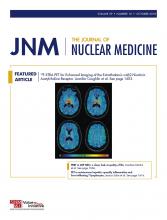REPLY: We thank Dr. Fleming for the interest shown to our paper (1).
In the present clinical research article, we applied a first-pass PET kinetic model that was developed and validated for blood flow (BF) measurement many years ago by Mullani et al. (2,3).
Kinetic modeling of 18F-FDG in tissue assumes that there is a large influx of 18F-FDG into tissue during the first pass of the tracer that is delivered as a function of the BF to the tissue. The input of this model is the arterial concentration of 18F-FDG. The tracer then diffuses across the capillary wall into the extravascular space and washes out of the tissue at a slower rate without being metabolically trapped in the cell. The model of Mullani et al. postulates that during the first pass of a highly extracted tracer through the tumor, most of it is retained in the tissue and the venous egress of the tracer is delayed by some time. BF can be calculated during this delay time by using a simple 1-compartment kinetic model.
We do not think that this method relies on a wrong pharmacokinetic model. As it is the case in most of the models, it relies on some assumptions, which may not be fulfilled. Because of incomplete tumor extraction of 18F-FDG, this simple pharmacokinetic model provides only an estimation of the BF. Regarding 18F-FDG uptake quantification, our PET systems complies with the European Association of Nuclear Medicine 18F-FDG PET/CT accreditation program, which is also endorsed by the European Organization for Research and Treatment of Cancer Imaging Group. Importantly, Mullani et al. validated their model by demonstrating that the estimated BF obtained with first-pass 18F-FDG measurement was linearly and highly correlated with BF determined with 15O-H2O PET, the reference standard (3). Later, Cochet et al. demonstrated that, in breast cancer, BF calculated with this model was associated with tumor angiogenesis biomarkers (4).
In our work, we did not aim to raise whether 18F-FDG PET can detect tumor changes during treatment (1). This has already been demonstrated decades ago. We aimed to evaluate the clinical usefulness of 18F-FDG PET in the neoadjuvant setting of breast cancer. We assessed whether these changes can predict pathologic complete response at the end of treatment, which is the only validated surrogate marker of improved survival in this setting. For this purpose, tumor metabolic changes clearly outperformed changes of the estimated tumor BF changes, obtained from the first-pass dynamic images.
We recognize that developing improved imaging approaches to measure tumor BF more accurately, including SPECT imaging, might modify our conclusions in the future. Nevertheless, these new methods require comparison with the more routinely available technique we have used to prove their superiority and moreover their ability to improve patients’ care. Contrary to what is written, Fleming et al. have not yet demonstrated in their previous paper the clinical usefulness of their method to predict breast cancer histologic response to chemotherapy (5).
Footnotes
Published online Aug. 30, 2018.
- © 2018 by the Society of Nuclear Medicine and Molecular Imaging.







